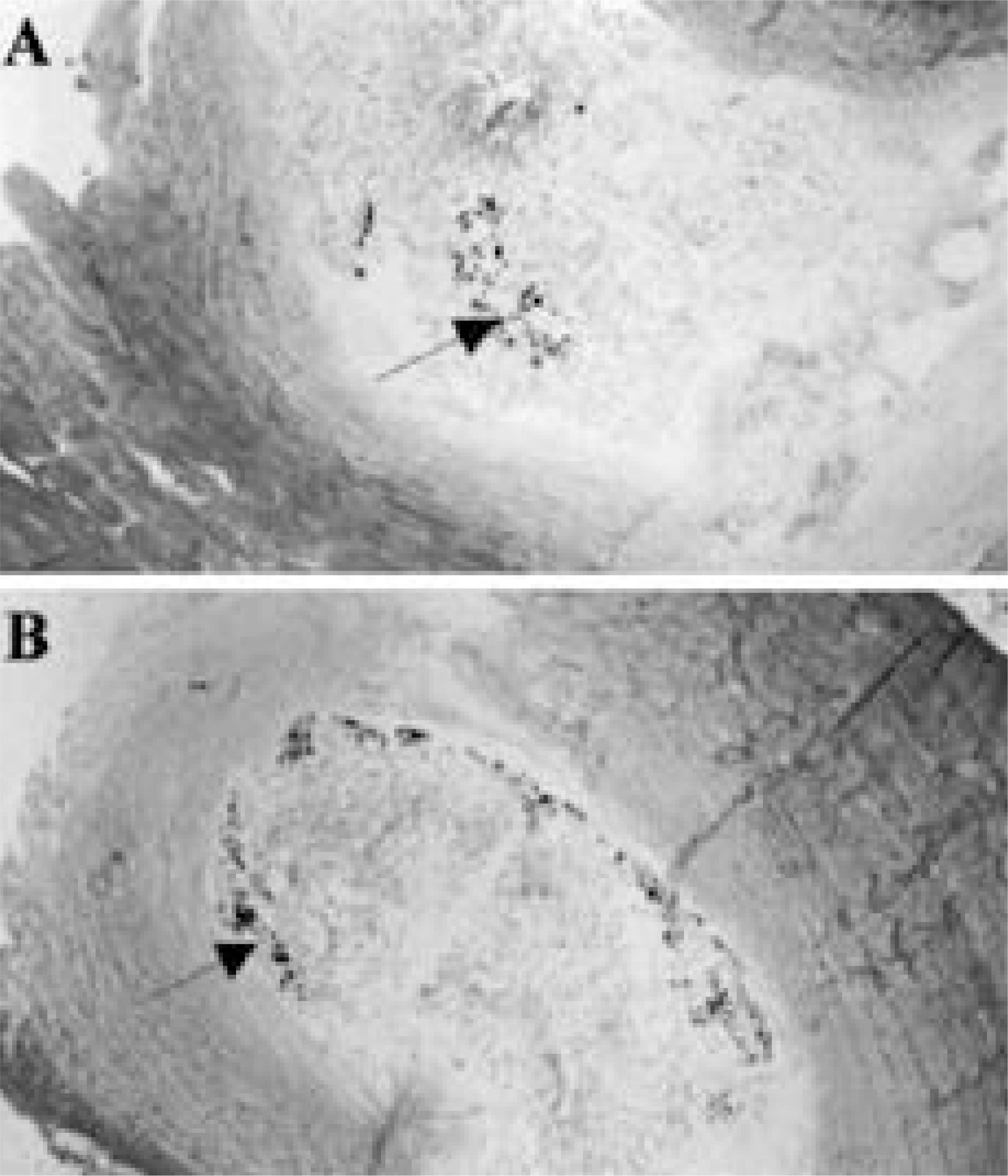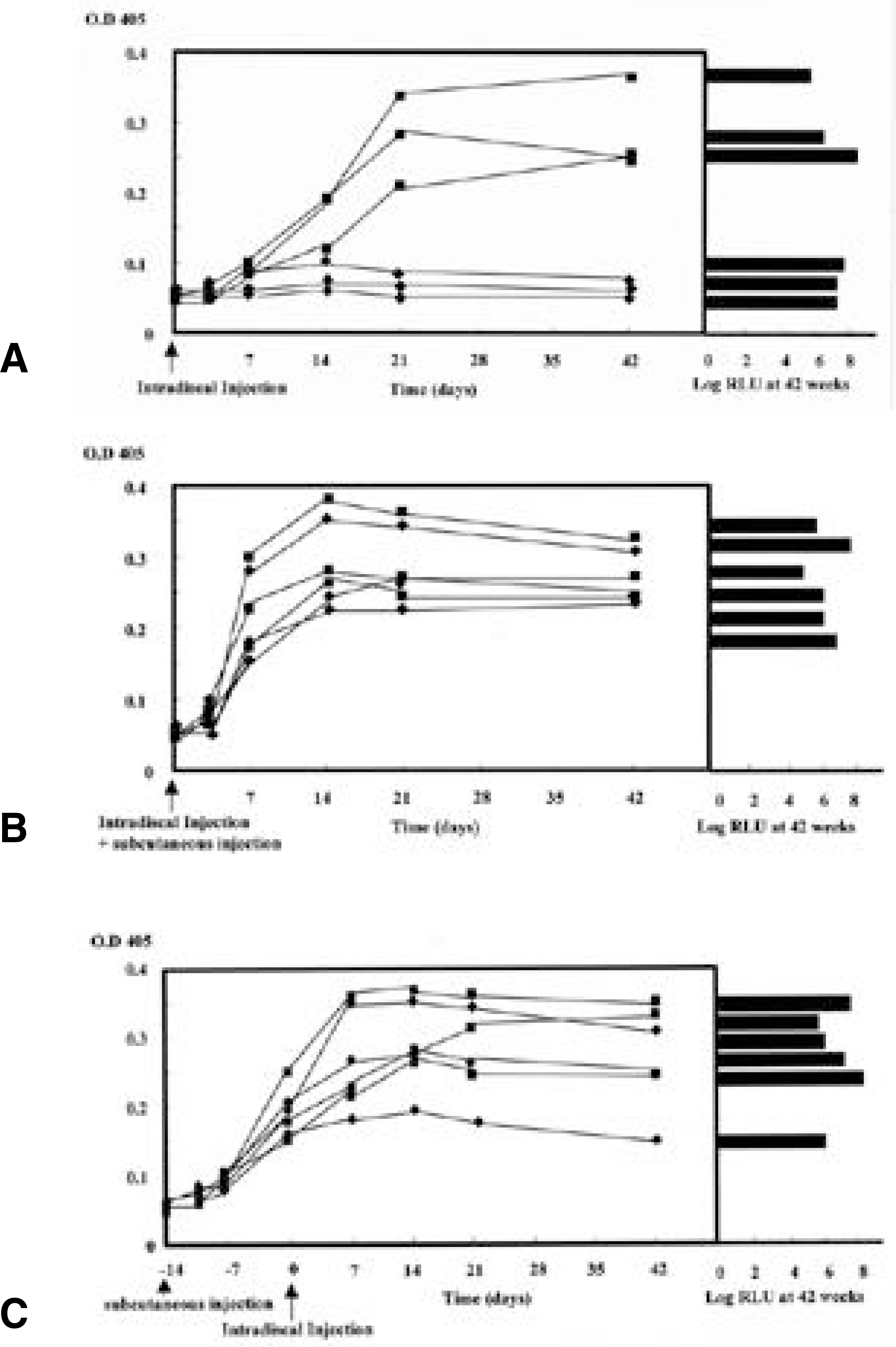Abstract
Materials and Methods
Twenty rabbits were utilized. A d/luciferase (adenovirus construct) were injected into nucleus pulposus of lumbar vertebrae. Group 1 received intradiscal injection of A d/luciferase only, Group 2 received subcutaneous and intradiscal injection simultaneously, Group 3 received subcutaneous injection then intradiscal injection with 2 weeks interval. Blood sam-ples were obtained serially after injection. A nimals were sacrificed at 7 weeks. A ntibody to adenovirus in peripheral blood was measured with ELISA and transgene expression was measured with standard luciferase kits.
Results
All rabbits in the Group 2 and 3 exhibited increased production of neutralizing antibody. There were clearly two sub-groups in Group 1, three rabbits exhibited production of antibody but remaining three rabbits showed little or no production of antibody. All rabbits showed robust increase in transgene expression regardless of titer of neutralizing antibody.
Go to : 
REFERENCES
1). Adams MA, May S, Freeman BJ, Morrison HP, Dolan P. Effects of backward bending on lumbar intervertebral discs. Relevance to physical therapy treatments for low back pain. Spine. 25:431–437. 2000.
2). Barr E, Leiden JM. Systemic delivery of recombi -nant proteins by genetically modified myoblasts. Science. 254:1507–509. 1991.
3). Bobechko WP. Auto-immune response to nucleus pulposus in the rabbit. J Bone Joint Surg Br. 47:574–580. 1965.

4). Borenstein D. Epidemiology, etiology, diagnostic evaluation, and treatment of low back pain. Curr Opin Rheumatol. 4:226–32. 1992.

5). Buckwalter JA. Aging and degeneration of the human intervertebral disc. Spine. 20:1307–1314. 1995.

6). Butler D, Trafimow JH, Andersson GB, McNeill TW, Huckman MS. Discs degenerate before facets. Spine. 15:111–113. 1990.

7). Day CS, Bosch P, Kasemkijwattana C, Menetrey J, Moreland MS, Fu FH, Ziran B and Huard J.Use of muscle cells to mediate gene transfer to the bone defect. Tissue Eng. 5:119–125. 1999.
8). De Wet JR, Wood KV, Deluca M, Helinski DR, Subramani S. Firefly luciferase gene: structure and expression in mammalian cells. Mol Cell Biol. 7:725–737. 1987.

9). Dhawan J, Pan LC, Pavlath GK, Travis MA, Lanctot AM, Blau HM. Systemic delivery of human growth hormone by injection of genetically engineered myoblasts. Science. 254:1509–1512. 1991.

10). Evans CH, Robbins PD. Possible orthopaedic applications of gene therapy. J Bone Joint Surg Am. 77:1103–1114. 1995.

11). Evans CH, Robbins PD. Genetically augmented tissue engineering of the musculoskeletal system. Clin Orthop. 367:S410–8. 1999.

12). Evans CH, Robbins PD. Potential treatment of osteoarthritis by gene therapy. Rheum Dis Clin North Am. 25:333–44. 1999.

13). Gertzbein SD. Degenerative disk disease of the lumbar spine: immunological implications. Clin Orthop. 129:68–71. 1977.
14). Gruber HE, Fisher EC, Desani B, Stasky AA, Hoelscher G, Hanley EN. .:. Human intervertebral disc cells from the annulus: three dimensional culture in agarose or alginate and responsiveness to TGF-b1. Exp Cell Res. 235:13–21. 1997.
15). Hardingham TE, Adams P. A method for the determination of hyaluronate in the presence of other gly -cosaminoglycans and its application to human intervertebral discs. Biochem J. 159:143–147. 1976.
16). Herkowitz HN, Abraham DJ, Albert TJ. Management of degenerative disc disease above an L5-S1 segment requiring arthrodesis. Spine. 24:1268–1270. 1999.

17). Lipson SJ, Muir H. Proteoglycans in experimental intervertebral disc degeneration. Spine. 6:194–210. 1981.

18). Melrose J, Ghosh P, Taylor TK, Hall A, Osti OL, Ver-non-Roberts B, Fraser RD. A longitudinal study of the matrix changes induced in the intervertebral disc by surgical damage to the annulus fibosus. J Orthop Res. 10:665–676. 1992.
19). Modic MT. Degenerative disc disease and back pain. Magn Reson Imaging Clin N Am. 7:481–491. 1999.

20). Moon SH, Kang JD, Nishida K, Gilbertson LG, Evan CH, Robbins PD. Human cervical intervertebral disc cells are susceptible to adenovirus-mediated gene therapy. Proceedings of Cervical Spine Research Society. 150-153. 1999.
21). Moon SH, Gilbertson LG, Nishida K, Knaub M, Muz-zonigro T, Robbins PD, Evans CH, Kang JD. Human intervertebral disc cells are genetically modifiable in-vitro by adenovirus-meidated gene transfer: Implications for clinical management of intervertebral disc disorder. Spine. 25:2573–9. 2000.
22). Moullier P, Bohl D, Heard JM, Danos O. Correction of lysosomal storage in the liver and spleen of MPS VII mice by implantation of genetically modified skin fibroblasts. Nat Genet. 4:154–159. 1993.

23). Naffakh N, Henri A, Villeval JL. Sustained delivery of erythropoietin in mice by genetically modified skin fibroblast. Pro Natl Acad Sci. 92:3194–3198. 1995.
24). Nishida K, Kang JD, Gilbertson LG, Moon SH, Suh JK, Vogt MT, Robbins PD, Evans CH. Modulation of the biologic activity of the rabbit intervertebral disc by gene therapy: An in vivo study of adenovirus-mediated transfer of the human transforming growth factor β 1 encoding gene. Spine. 24:2419–2425. 1999.
25). Nishida K, Kang JD, Suh J-K, Robbins PD, Evans CH, Gilbertson LG. Adenovirus-mediated gene transfer to nucleus pulposus cells: Implication for the treatment of intervertebral disc degeneration. Spine. 23:2437–2443. 1998.
26). Osada R, Ohshima H, Ishihara H, Yudoh K, Sakai K, Matsui H, Tsuji H. Autocrine/paracrine mechanism of insulin-like growth factor-1 secretion, and the effect of insuline-like growth factors-1 on proteoglycan synthesis in bovine intervertebral discs. J Orthop Res. 14:690–699. 1996.
27). Pearce RH, Grimmer BJ, Adams ME. Degeneration and the chemical composition of the human lumbar intervertebral disc. J Orthop Res. 5:198–205. 1987.

29). Takegami K, Matuda K and Kumano F.Osteoge nicprotein-1 is most effective in stimulating nucleus pulposus and annulus fibrosus cells to repair their matrix after chondroitinase ABC-induced chemonucleolysis. 45th Annual Meeting Trans Orthop Res Soc. 201. 1999.
30). Thompson JP, Oegema TR, Bradford DS. Stimulation of mature canine intervertebral disc by growth facors. Spine. 16:253–260. 1991.
31). Tripathy SK, Black HB, Goldwasser E, Leiden JM. Immune responses to tansgene-encoded proteins limit the stability of gene expression after injection of replication-defective adenovirus vectors. Nat Med. 2:545–550. 1996.
32). Waddell G. Low back pa in: A twentieth century health care enigma. Spine. 21:2820–2825. 1996.
33). Yang Y, Haeker SE, Su Q, Wilson JM. Immunology of gene therapy with adenoviral vectors in mouse skeletal muscle. Human Mol Genetic. 5:1703–1712. 1996.

34). Yang Y. Nunes FA. Berencsi K. Furth EE. Gonczol E, Wilson JM. Cellular immunity to viral antigens lim -its E1-detected adenovirus for gene therapy. Proc Nat Acad Sci. 91:4407–4411. 1994.
Go to : 
 | Fig. 1.Qualitative analysis of intradiscal transgene expression of A) 3 weeks, B) 6 weeks after direct application of Ad/lacZ into lumbar intervertebral discs of adult New Zealand white rabbits. There were strong transgene expresson indicated by the arrow (dark staining, originally blue color) in the nucleus pulposus without evidence of infiltration of inflamatory cell and neovascularization (X-Gal staining with counter staining with hematoxylin-eosin, Original magnification × 100). |
 | Fig. 2.Sequential production of specific antibody for adenoviral proteins in peripheral blood as function of time. Transverse bar chart on the right denote intradiscal transgene expression in each individual rabbit. A Three rabbits injected with Ad/luciferase produced little or no neutralizing antibody while remaining three rabbits showed production of antibody (likely due to leakage of adenovirus from injected disc). B Six rabbits in Group 2 after simultaneous injection of Ad/luciferase into subcutaneous tissue and intervertebral disc produced neutralizing antibody in significant amount. C Six rabbits in Group 3 were immunized two weeks prior to intradiscal gene transduction with injection of Ad/luciferase into subcutaneous tissues. All rabbits showed significant amount of transgene (luciferase) expression. |




 PDF
PDF ePub
ePub Citation
Citation Print
Print


 XML Download
XML Download